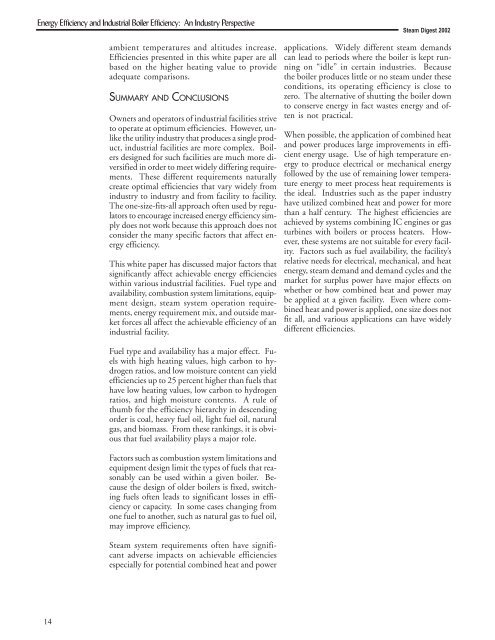Steam Digest 2002 - CiteSeerX
Steam Digest 2002 - CiteSeerX
Steam Digest 2002 - CiteSeerX
You also want an ePaper? Increase the reach of your titles
YUMPU automatically turns print PDFs into web optimized ePapers that Google loves.
Energy Efficiency and Industrial Boiler Efficiency: An Industry Perspective<br />
14<br />
ambient temperatures and altitudes increase.<br />
Efficiencies presented in this white paper are all<br />
based on the higher heating value to provide<br />
adequate comparisons.<br />
SUMMARY AND CONCLUSIONS<br />
Owners and operators of industrial facilities strive<br />
to operate at optimum efficiencies. However, unlike<br />
the utility industry that produces a single product,<br />
industrial facilities are more complex. Boilers<br />
designed for such facilities are much more diversified<br />
in order to meet widely differing requirements.<br />
These different requirements naturally<br />
create optimal efficiencies that vary widely from<br />
industry to industry and from facility to facility.<br />
The one-size-fits-all approach often used by regulators<br />
to encourage increased energy efficiency simply<br />
does not work because this approach does not<br />
consider the many specific factors that affect energy<br />
efficiency.<br />
This white paper has discussed major factors that<br />
significantly affect achievable energy efficiencies<br />
within various industrial facilities. Fuel type and<br />
availability, combustion system limitations, equipment<br />
design, steam system operation requirements,<br />
energy requirement mix, and outside market<br />
forces all affect the achievable efficiency of an<br />
industrial facility.<br />
Fuel type and availability has a major effect. Fuels<br />
with high heating values, high carbon to hydrogen<br />
ratios, and low moisture content can yield<br />
efficiencies up to 25 percent higher than fuels that<br />
have low heating values, low carbon to hydrogen<br />
ratios, and high moisture contents. A rule of<br />
thumb for the efficiency hierarchy in descending<br />
order is coal, heavy fuel oil, light fuel oil, natural<br />
gas, and biomass. From these rankings, it is obvious<br />
that fuel availability plays a major role.<br />
Factors such as combustion system limitations and<br />
equipment design limit the types of fuels that reasonably<br />
can be used within a given boiler. Because<br />
the design of older boilers is fixed, switching<br />
fuels often leads to significant losses in efficiency<br />
or capacity. In some cases changing from<br />
one fuel to another, such as natural gas to fuel oil,<br />
may improve efficiency.<br />
<strong>Steam</strong> system requirements often have significant<br />
adverse impacts on achievable efficiencies<br />
especially for potential combined heat and power<br />
<strong>Steam</strong> <strong>Digest</strong> <strong>2002</strong><br />
applications. Widely different steam demands<br />
can lead to periods where the boiler is kept running<br />
on “idle” in certain industries. Because<br />
the boiler produces little or no steam under these<br />
conditions, its operating efficiency is close to<br />
zero. The alternative of shutting the boiler down<br />
to conserve energy in fact wastes energy and often<br />
is not practical.<br />
When possible, the application of combined heat<br />
and power produces large improvements in efficient<br />
energy usage. Use of high temperature energy<br />
to produce electrical or mechanical energy<br />
followed by the use of remaining lower temperature<br />
energy to meet process heat requirements is<br />
the ideal. Industries such as the paper industry<br />
have utilized combined heat and power for more<br />
than a half century. The highest efficiencies are<br />
achieved by systems combining IC engines or gas<br />
turbines with boilers or process heaters. However,<br />
these systems are not suitable for every facility.<br />
Factors such as fuel availability, the facility’s<br />
relative needs for electrical, mechanical, and heat<br />
energy, steam demand and demand cycles and the<br />
market for surplus power have major effects on<br />
whether or how combined heat and power may<br />
be applied at a given facility. Even where combined<br />
heat and power is applied, one size does not<br />
fit all, and various applications can have widely<br />
different efficiencies.
















